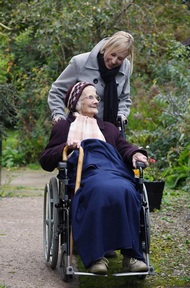England may need to employ one million more care workers by 2025 to meet growing demand
An understanding of the care workforce is crucial if the sector is to successfully reform and expand to answer the challenges of an ageing population, with projected figures suggesting that the number of UK adults aged over 65 is set to double to 20m by 2050.

Research from workforce development experts Skills for Care further highlights the pressing need to support policies that allow for the care industry to draw from an effective skills-base, estimating that England’s care workforce alone needs to grow by anywhere up to 82 per cent by 2025.
So far the annual report ‘The state of the adult social care sector and workforce in England, 2012’, shows that the industry is seeing success in recruiting more employees, despite the challenges of austerity leaving a funding shortfall that care provider Bupa claim stands at £892m. With more healthy recruitment programmes needed, however, the sector is faced with overcoming stigma and low pay at the same time as keeping service standards high and remaining market competitive.
Currently, England’s care workforce is estimated at some 1.63m care workers, showing an annual increase of 4.5 per cent. The figures suggest that the ‘personalisation agenda’ is responsible for this increase, with the majority of new positions having become available due to an increase in direct payment recipients. These now make up 23 per cent of the workforce, with 63 per cent belonging to independent employers and only 10 per cent working for local authorities.
Skills for Care chief executive Sharon Allen hopes the report will have a big impact upon policymakers, commenting: “We once knew very little about the adult social care workforce and these detailed reports are our contribution to making sure we have solid data provided by thousands of frontline employers that will help us make informed decisions in tough times.”
“We are incredibly grateful to those employers who are already enjoying the many business benefits of the National Minimum Data Set for Social Care [NMDS-SC] including access to funding and training, for supplying more than 750,000 worker records which really helps us to understand what the sector looks like now and make projections about the future workforce.”

The report also finds that the care industry is heavily reliant on female workers, who make up 82 per cent of the total workforce, while there are also an estimated 5.3m unpaid carers in the UK whose numbers are expected to rise considerably.
Professor David Croisdale-Appleby, OBE, is also keen for the statistics to be taken seriously: “The need for us to create a capable, committed and confident workforce to meet present and future needs has never been more pressing, and will be no easy task to achieve. But it is clear that the information in this report will be a key contributor to the ability of our sector to meet that challenge, and in ensuring we make greater choice and control a daily reality for people who access care and support services in our communities.”
Figures also highlight an average staff turnover rate of 19 per cent, which is higher than most UK averages – usually positioned somewhere between 10 and 15 per cent – although significantly lower than the 40 per cent turnover estimated by the National Care Forum back in 2008.
According to Skills for Care, half of the current workforce has been involved in social care or related work for more than six years but, despite showing more positive figures than some estimates might have produced, the industry is still potentially faced with finding another one million workers by 2025.
Dr Martin Ruhs, director of the Migration Observatory at the University of Oxford believes that the Government’s immigration policy is one key factor that might prove harmful to recruitment, saying:
“At the moment the UK’s social care sector is highly reliant on migrant labour. In London, for example, around two thirds of social care assistants are foreign born. A significant reason for this dependence on migrants is that the sector is characterised by low wages, difficult work and antisocial hours. The public funding of much of the sector is one of the reasons wages are low. There has been chronic underinvestment in the sector which has, as a consequence, developed a structural demand for low cost labour. In practice, this demand has been increasingly met by migrant workers, especially in places with high living costs like London.

“The Government is committed to reducing net migration to the UK from its current level of 216,000 per year to less than 100,000 per year, which presents challenges to the social care sector if it is to expand its workforce further: to encourage British workers to fill these roles it seems likely that higher wages would have to be paid – which will mean higher cost of provision and, therefore, presumably higher costs for local authorities. Alternatively, either the sector will need to do more with fewer people or, if the reliance on low-paid migrant workers is to continue, its impacts on government policy will need to be considered.”
The Skills for Care report estimates that 82 per cent of the adult social care workforce are British nationals, but Dr Ruhs’s concerns are hard to dismiss within a sector that shows great variation from region to region. Care providers and councils are urged to get to know their local demand for care provision and structure their future plans with a tailored approach.
2012 figures do not yet give any impression that, like its client-base, the workforce itself is ageing, although a recent ‘Health of the Workplace’ report from Aviva claims this might be a scenario many UK sectors face over the long term, with two-fifths of businesses acknowledging that an ageing workforce is a real concern.
Latest News Analysis
 04-Sep-19
Extra £1.5 billion announced for social care in Chancellor's Spending Review
04-Sep-19
Extra £1.5 billion announced for social care in Chancellor's Spending Review
 02-Jul-19
Department of Health forced to rethink care homes' nursing rates after legal challenge
02-Jul-19
Department of Health forced to rethink care homes' nursing rates after legal challenge
 18-Jun-19
Overnight care workers forced to sleep in offices and told 'bring your own bedding'
18-Jun-19
Overnight care workers forced to sleep in offices and told 'bring your own bedding'
 14-Jun-19
Back in the closet: Third of care home staff have had no LGBT+ awareness training
14-Jun-19
Back in the closet: Third of care home staff have had no LGBT+ awareness training
 11-Jun-19
PM candidates on social care: Rory Stewart calls fixing care an 'unfinished revolution'
11-Jun-19
PM candidates on social care: Rory Stewart calls fixing care an 'unfinished revolution'